In this paper Maximum power point tracker battery charger is proposed for extracting maximum power from a photovoltaic panel to charge the battery. The output power of the PV system continuously varies with change in irradiance and temperature. It is very important to improve the efficiency of charger. There are number of maximum power point tracking (MPPT) methods available to operate the PV system at maximum power point. The proposed system have used Perturb & Observe (P&O) MPPT algorithm for the design and implementation. When irradiance and temperature are constant or slowly varying, the P&O method tracks MPP steadily and calculate the operating point at which the battery is capable of producing maximum power. In this method, the controller provides the PWM signal to adjust the voltage, adjustment is done by Buck converter and measures power, if the power increases, further adjustments in that direction are tried until power no longer increases
Keywords |
| Solar PV System, MPPT, P&O Algorithm, buck DC to DC converter, AVR Microcontroller. |
INTRODUCTION |
| Solar energy is one of the most important renewable energy sources that have been gaining increased attention in recent
years. Solar energy is plentiful; it has the greatest availability compared to other energy sources. The amount of energy
supplied to the earth in one day by the sun is sufficient to power the total energy needs of the earth for one year. Solar
energy is clean and free of emissions, since it does not produce pollutants or by-products harmful to nature. The
conversion of solar energy into electrical energy has many application fields. Recently, research and development of
low cost flat-panel solar panels, thin-film devices, concentrator systems, and many innovative concepts have increased.
In the near future, the costs of small solar-power modular units and solar-power plants will be economically feasible for
large-scale production and use of solar energy. |
| In this paper we have presented the photovoltaic solar panel’s operation. The foremost way to increase the efficiency of
a solar panel is to use a Maximum Power point Tracker (MPPT), a power electronic device that significantly increases
the system efficiency. By using it the system operates at the Maximum Power Point (MPP) and produces its maximum
power output. Thus, an MPPT maximizes the array efficiency, thereby reducing the overall system cost.In addition, we
attempt to design the MPPT by using the algorithm of a selected MPPT method which is “Perturb and Observe” and
implement it by using a DC- DC Converter. We have found various types of DC-DC converter. Among them we have
selected the most suitable converter which is “BUCK” converter, for our design. |
| PV generation systems generally use a microcontroller based charge controller connected to a battery and the load. A
charge controller is used to maintain the proper charging voltage on the batteries. As the input voltage from the solar
array, the charge controller regulates the charge to the batteries preventing any overcharging. So a good, solid and
reliable PV charge controller is a key component of any PV battery charging system to achieve systems maximum
efficiency. Whereas microcontroller based designs are able to provide more intelligent control and thus increases the
efficiency of the system. |
LITERATURE REVIEW |
| There are many MPPT algorithm which can be used for implementation viz. Incremental conductance method, constant
voltage method, Fuzzy logic based method etc. Different MPPT algorithms [8], [II], [12] are briefed about their
features and limitations as follows |
| 1) Incremental conductance (INC) method [8], [11] of tracking the MPP does not depend upon PV array, tracking
efficiency is good, and implementation is medium. Sensing parameters are voltage and current, convergence speed is
medium and of analog type. |
| 2) Fuzzy logic control based MPPT [8], [11] is PV array dependent, Tracking efficiency is good, implementation is
very complex, convergence speed is fast and of digital type. |
| 3) Neural network based MPPT [11] is also PV array dependent, tracking efficiency is good, implementation is very
complex, convergence speed is fast and of digital type. |
| 4) Linear current control based MPPT [9], [12] is PV array dependent, tracking efficiency is not so good,
implementation complexity is medium, convergence speed is fast, sensing parameter is irradiance and of digital type. |
| 5) Temperature based MPPT [11] depends upon PV array, tracking efficiency is excellent, implementation is simple
and MPP is comparatively accurate and sensing parameters are voltage and temperature. |
| 6) Array reconfiguration based MPPT [11] is PV array dependent, tracking efficiency is poor, convergence speed is
slow, implementation complexity is high, sensing parameters are voltage and current and of digital type. |
| 7) Perturb and observe based MPPT [8], [9], [11] is not PV array dependent, tracking efficiency is good but with
unstable operating points, implementation is simple, sensing parameters are voltage and current. |
| 8) Advanced Perturb and Observe based MPPT is not PV array dependent, tracking efficiency is very good with stable
MPPs, implementation is medium, sensing parameters are voltage and current. |
| Out of many MPPT algorithms, Perturb and observe (P&O) algorithm [10] is mostly used for increasing the efficiency
of PV system due to its simpler implementation, high reliability and better efficiency. |
SYSTEM DESCRIPTION |
| The objective of the paper is to present a novel cost effective and efficient microcontroller based MPPT system for
solar photovoltaic system to ensure the maximum power point operation at all changing Environmental condition. The
P&O MPPT algorithm is used to control the maximum transfer power from a PV panel. This algorithm is executed by
an AVR Atmega16 microcontroller using the PV voltage and current data to control the duty cycle of a pulse width
modulation signal applied to a DC/DC converter. |
| A. MICROCONTROLLER |
| The MPPT control circuit is implemented in a microcontroller Atmega16 AVR, that has eight 10-bits analog-to-digital
(A/D) converters and two four PWM mode signals. The buck converter is controlled by the microcontroller. It read the
voltage and current of the solar panels through the A/D port of controller and calculates the output power. It also
calculate power by reading the voltage and current of battery side in same way and send corresponding control signal to
the buck converter and control the duty cycle of the converter by PWM signal through controller to accordingly
increase, decrease or turn off the DC to DC converter. The ATMEGA16 is a perfect combination of performance,
features, and low power consumption for this application The control circuit compares the PV output power before and
after a change in the duty ratio of the DC/DC converter control signal. It is expected that the MPP presents a constant
oscillation inherent to the algorithm. The following Fig no 2 is the design of AVR with LCD and oscillator Connection
in proteus software. |
| B. DC TO DC CONVERTER |
| There are several topologies available for DC-DC converter. Among them buck converter is in an increasingly popular
topology, particularly in battery powered applications, as level of the output voltage can be changed with respect to
input voltage |
| The commonly used a converter in PV systems is a DC/DC power converter. It ensures, through a control action, the
transfer of the maximum of electrical power to the load. The structure of the converter is determined according to the
load to be supplied. In this article we focus on the step-down DC/DC converter (Buck converter). MPPT uses the same
converter for a different purpose, such as regulating the input voltage at the Maximum power point and providing load
matching for the maximum power transfer. |
P & O ALGORITHM |
| A typical solar panel converts only 30 to 40 percent of the incident solar irradiation into electrical energy. Maximum
power point tracking technique is used to improve the efficiency of the solar panel. According to Maximum Power
Transfer technique, the output power of a circuit is maximum when the source impedance matches with the load
impedance. In the source side a buck converter is connected to a solar panel in order to enhance the output voltage. By
changing the duty cycle of the buck converter appropriately by PWM signal the source impedance is matched with that
of the load impedance. There are various MPPT techniques are proposed [3]. Among those methods, the perturb and
observe (P&O) and incremental conductance (INC) methods are widely used although they have some problems such
as the oscillation around MPP and confusion by rapidly changing atmospheric conditions [5]
In this paper perturb and observe MPPT algorithm is used. In this method the controller adjusts the voltage by a small
amount from the array and measures power, if the power increases, further adjustments in the direction are tried until
power no longer increases. This is called P&O method. Due to ease of implementation and cost effectiveness, it is the
most commonly used MPPT method. |
| The voltage to a cell is increased initially, if the output power increase, the voltage is continually increased until the
output power starts decreasing. Once the output power starts decreasing, the voltage to the cell decreased until
maximum power is reached. This process is continued until the MPPT is obtained. This result is an oscillation of the
output power around the MPP. PV module’s output power curve as a function of voltage (P-V curve), at the constant
irradiance and the constant module temperature, assuming the PV module is operating at a point which is away from
the MPP. |
| This P&O algorithm periodically increment or decrement the output terminal voltage of the PV cell and comparing the
power obtained in the current cycle with the power of the previous one . If the power is increased, then it is supposed
that it has moved the operating point closer to the MPP. Thus, further voltage perturbations in the same direction
should move the operating point toward the MPP. If the power decreases, the operating point has moved away from the
MPP, and the direction of perturbation should be reversed to move back toward the MPP. |
HARDWARE IMPLIMENTATION |
| BUCK CONVERTER |
| The DC/DC converter is a Buck converter working at a switching frequency of 14 KHz. They consist of one P-channel
MOSFET switching transistor driven by the AVR via one bipolar NPN transistor. The switching transistor is connected
to an inductor, a diode and a capacitor . An additional diode prevents the battery from supplying voltage into the
microcontroller when the power is disconnected. When the switching transistor is ON the capacitor is charged from the
input via the inductor (the inductor is also charged up). When the switch is opened , the inductor will try to maintain its
current-flow by inducing a voltage. The current flows through the diode and the inductor will charge the capacitor.
Then the cycle repeats itself. If the duty cycle is decreased, by shorter on time, longer off time, the voltage will
decrease. If the duty cycle is increased (longer on timer, shorter off time), the voltage will increase. The buck-converter
is most efficient running on a duty cycle of 50%. |
RESULT |
| The experimental results of battery charging using the P&O MPPT algorithm are divided in two separated tests. First
test, using one PV panel with Pmax=10 W, Vmp=17 V, Imp=0.56 A, under standard temperature condition and one leadacid
battery with V = 12 V and Imax = 7Ah, that consists, first, the PV panel is connected directly to the battery. From
first test it can be seen that charging the 12V battery with the P&O algorithm, the absorbed power from the PV panel is
around 7.35W with charging current of 0.592 A in Constant Current mode. |
| In the Second test, the PV panel is connected to the battery using the developed MPP tracker board running the MPPT
algorithm. From first test it can be seen that charging the 12V battery with the P&O algorithm, the absorbed power
from the PV panel is around 12.5W with charging current of 1.04 A. The experimental setup with the MPPT has
provided always more delivered energy to the battery than the direct connection. The MPPT has increased the PV panel
capacity of supply energy in 87% using a 12V battery. |
CONCLUSION |
| This work presented a prototype board based in a small microcontroller that controls the lead acid battery charging
process and also the correct used of the lead-acid battery. The control algorithm executes the P&O maximum power
point tracking function allowing, according to solar irradiance, the transfer of maximum energy generated by
photovoltaic panel to the battery. This P&O algorithm increase the efficiency power transference in comparison to
systems that have not a MPPT (direct connection), reducing the size and the cost of the PV panel. |
| This board assures the fast, safe and complete battery (lead acid) charging process and also monitor its discharge. For
future work the complete charging process should be analyzed to compare with another system working without P&O
MPPT algorithm. From the preliminary results it is expect that the charging process using the MPPT algorithm will be
faster. |
Figures at a glance |
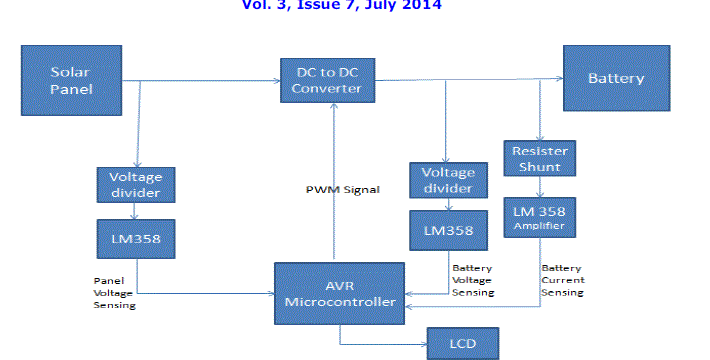 |
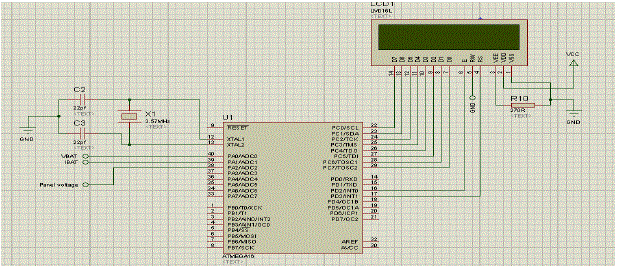 |
 |
| Figure 1 |
Figure 2 |
Figure 3 |
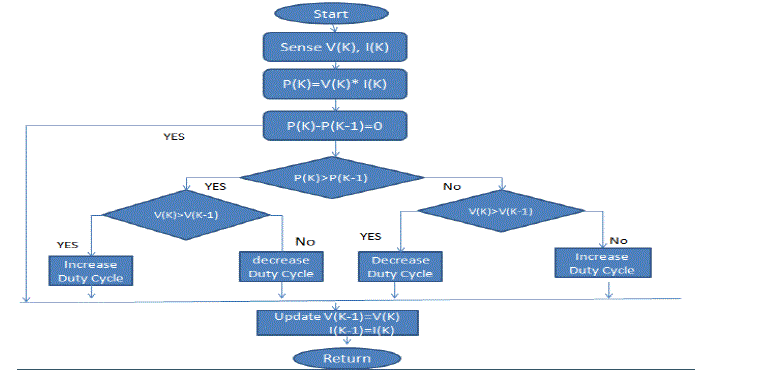 |
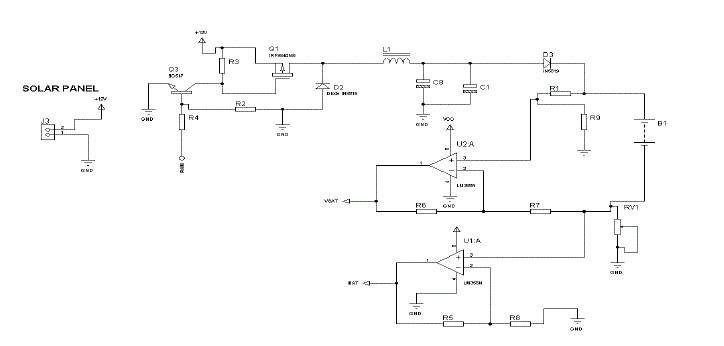 |
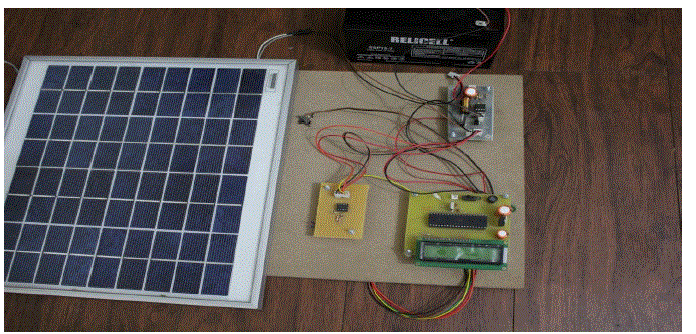 |
| Figure 4 |
Figure 5 |
Figure 6 |
|
| |
References |
- Sathish Kumar Kollimalla Student Member, IEEE, Mahesh Kumar Mishra Senior Member, IEEE âÂÂNovel Adaptive P&O MPPT Algorithm forPhotovoltaic System Considering Sudden Changes in Weather Conditionâ IEEE International conference on ICCEP,2013
- MoacyrAureliano Gomes de Brito, Luigi Galotto, Jr., Leonardo PoltronieriSampaio,Guilherme de Azevedo e Melo, and Carlos AlbertoCanesin, Senior Member, IEEE âÂÂEvaluation of the Main MPPT Techniques for Photovoltaic Applicationsâ IEEE TRANSACTIONS ONINDUSTRIAL ELECTRONICS, VOL. 60, NO. 3, MARCH 2013
- D. K. Sharma, Purohit G âÂÂAdvanced Perturbation and Observation (P&O) based Maximum Power Point Tracking (MPPT) of a Solar Photo-Voltaic SystemâÂÂ2012 5TH International Conference on Power Electronics
- Ali Chermitti, Omar Boukli-Hacene, Bencherif Mohamed âÂÂImprovement of the âÂÂPerturb and Observeâ MPPT Algorithm in a PhotâÂÂovoltaicSystem under Rapidly Changing Climatic Conditionsâ International Journal of Computer Applications (0975 â 8887) Volume 56â No.12,October 2012
- Yi-HwaLiu,Rong-CengLeou ,Jeng-Shiung Cheng âÂÂDesign and Implementation of a Maximum Power Point Tracking Battery ChargingSystem for Photovoltaic ApplicationsâÂÂpower tech, 2012 russia.
- Peng Fang, Pu Wang âÂÂThe Research of Photovoltaic Street Light Control System with MPPTâ IEEE 2011 3rd International Workshop onIntelligent Systems and Applications (ISA)
- Siwakoti, Yam Prasad1, BhupendraBimalChhetri, BrijeshAdhikary, DiwakarBista â Microcontroller based intelligent DC/DC converter totrack maximum power point for solar photovoltaic moduleâÂÂ2010 international conference on CITRES M.S.Sivagamasundari1, Dr.P.MelbaMary2,V.K.Velvizhi3 âÂÂMaximum Power Point Tracking For Photovoltaic System by Perturb and Observe Method Using Buck BoostConverterâ International Journal of Advanced Research in Electrical, Electronics and Instrumentation Engineering Vol. 2, Issue 6, June 2013
- D. P. Hohm and M. E. Ropp, "Comparative study of maximum power point tracking algorithms," Prog. Photovolt: Res. Appl., vol. II, pp. 47-62,2003
- Marcelo GradellaVillalva, Jonas Rafael Gazoli, Ernesto RuppertFilho,"Analysis and simulation of the P&O MPPT algorithm using alinearized PV array model", Industrial Electronics, 2009. IECON '09. 35th Annual Conference of IEEE.
- Mohammed A. Elgendy, Bashar Zahawi, and David J. Atkinson, "Assessment of Perturb and Observe MPPT Algorithm Implementation
- Techniques for PV Pumping Applications" IEEE Transactions on Sustainable Energy, Vol. 3, no. 1, January 2012 [11] Techniques", IEEETransactions on Energy Conversion, vol. 22, no.2,June,2007.
- Moacyr A. G. de Brito, Luigi G. Junior, Leonardo P. Sampaio, Guilherme A. e Melo, Carlos A. Canes in, "Main Maximum Power PointTracking (MPPT) strategies intended for Photovoltaics, IEEE Transaction on Energy Conversion, Vol. 22,No. 2,June2007
|